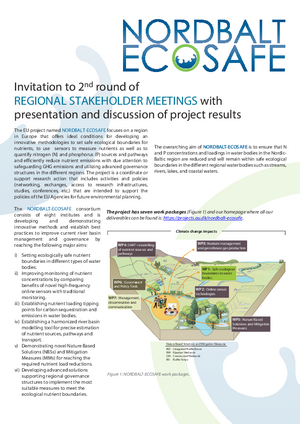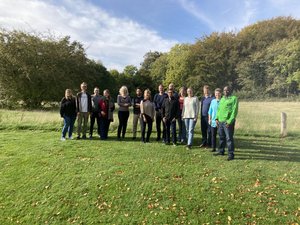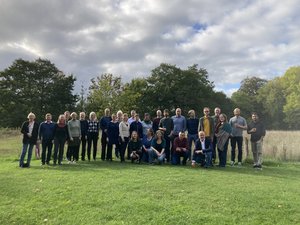News
News 2025
Policy brief No. 7: Stoichiometry vs. Single Element Approaches for eutrophication management
Agricultural practices, particularly widespread use of nitrogen (N) and phosphorus (P) fertilizers, have increased nutrient fluxes from land to sea. Simultaneously, water regulation and damming may have decreased silicon (Si) fluxes from terrestrial to marine systems. This combination can create stoichiometric imbalances with ecological consequences. Read the report here.
Land Use and Water Quality conference 3-6th June 2025
NORDBALT-ECOSAFE and the two sister projects NAPSEA and NEW-HARMONICA hosted a special session during the recent held Land Use and Water Quality conference 3-6th June 2025 in Aarhus, Denmark (see link to the programme of the LUWQ1015: https://www.luwq2025.nl/wp-content/uploads/2025/06/Programme-Overview-LUWQ-06062025.pdf). A total of ca. 100 participants took part in the special session where the three EU Horizon projects presented their results so far achieved. See the abstracts from the NORDBALT-ECOSAFE presentation here.
Deliverable Work package D1.3
This report presents safe ecological good/moderate (GM) boundaries for nutrients (= nutrient target concentrations) in different types of lowland lakes and rivers in the Nordic and Central-Baltic regions, as well as estimates of how climate change is likely to affect the nutrient-sensitive biological quality elements (BQEs). The results can be used to support planning of nutrient reduction measures that would be in line with the safe ecological GM boundaries for nutrients and also counteract negative impacts of climate change on the BQEs, thereby supporting the achievement of good status for nutrient sensitive BQEs in the years to come. See the report here.
Deliverable Work package D3.4
WP3 has submitted its deliverable D3.4 which is a research paper with the title ‘Northern Nordic river mouth N:P:Si stoichiometry: spatiotemporal patterns and implications for eutrophication management’ to Scientific Reports.
D3.4 includes for now the title page and abstract from the submitted paper to Scientific Reports.
Deliverable Work package D2.3
Deliverable D2.3 has been finalized by WP2 and is currently submitted as a paper with the title ‘Using optical sensors to assess the impact of infrequent sampling on the uncertainty of stream annual mean turbidity and total phosphorus concentrations, and how this can affect the water quality status’. The paper is submitted to Environmental Monitoring and Assessment ‘ to Journal of Environmental Monitoring and Assessment on 12th April 2025.
Lead author is Eva Skarbøvik, NIBIO, Norway with co-authors from the participating institutes.
Deliverable Work package D1.4
WP1 has submitted the final deliverable (D1.4) being a research paper last week in April 2025 to the Journal Environmental Monitoring and Assessment (EMA).
The title of the submitted paper is ‘Setting safe ecological boundaries for nutrients and exploring climate impacts on biological resilience in lowland lakes and rivers in the Nordic and Central European regions’ and the paper is lead by Ja-Erik Thrane and Anne Lyche Solheim from NIVA, Norway.
The Title page and abstract of the submitted paper can be found with this link
Deliverable Work package D4.3
Our SWAT+ modellers in the six river basins have drafted a new policy brief No. 6 from the project, that focus on the needs to develop improved water quality modelling in EU to assist in closing the gab between current conditions and boundary conditions for our different water body types. See the policy brief no. 6 here.
NORDBALT-ECOSAFE project hosted a special invited session in December 2024
The session was about our project results so far at a HELCOM PLC-8 meeting 17th December 2024. See the agenda here.
News 2024
Deliverable Work package D5.4 - dated 31st october 2024
Work Package news
Work Package 6 with the second deliverable (D6.2) 18th April 2024 (M202)
Regional project meetings in October-November 2024
The project has started its first preparations for the upcoming regional project meetings with stakeholders in our river basins. The new round of regional meetings are to be held during the period October-November 2024. As part of our preparations we have made a flyer that together with local information will be used as a first invitation to the meetings in our partner countries.
NORDBALT-ECOSAFE Midterm Meeting 19-21st February 2024 at Hejmdal in Aarhus, Denmark
The EU Horizon project held its midterm 3-days meeting with 32 representatives from all institutes in the consortium. We had a guest visit with a virtual presentation from our two sister projects: NEW-HARMONICA and NAPSEA, as well as a presentation from the EU project OPTAIN.
Two group photos with most of the participants is shown below and a link to the programme for the midterm meeting can found here.
- NORDBALT-ECOSAFE will hold a mid-term project meeting from 19-21st February 2024 at Aarhus University, Campus, Denmark (link to programme for our meeting). At the meeting on Tuesday 20th February the coordinators of our two sister projects (NEW-HARMONICA and NAPSEA) will present their projects with their deliverables.
-
The coordinators of the three EU sister project. NEW-HARMONICA, NAPSEA and NORDBALT-ECOSAFE had their 3rd meeting on 15th January 2024. The coordinators will seek permission for hosting a joint special session at the upcoming LUWQ conference in Aarhus, Denmark in June 2025.
News 2023
- Work Package 1 with the second deliverable (D1.2) on 2nd November 2023.
- Work Package 3 has its first deliverable (D3.1) 30th August 2023
- Training seminar was held in March 2023 (visit from Norway)
- Next all partner meeting in NordBalt-Ecosafe is planned for 19th to 21st February 2024 at Campus Aarhus, Denmark. More details about the meeting with a programme for the meeting will be announced in early autumn 2023.
- Work Package 5 has its first deliverable (D5.1) 30th April 2023
- Work Package 1 has its first deliverable (D1.1) 11th April 2023
- The regional project meetings with stakeholders are now planned and will take place at the following dates:
- River Odense, Denmark: 18th January 2023
- River Örsundaån, Sweden: 24th January 2023
- River Hobølelva, Norway: 26th January 2023
- River Berze, Latvia: 1st February 2023
- River Tyrnävänjoki, Finland: 8th February 2023
- River Slupia, Poland: 9th February 2023
- On 30th November 2022 NORDBALT-ECOSAFE host the second online meeting with two sister projects named ‘NAPSEA’ and ‘NEW_HARMONICA’ to discuss and plan for a joint Roadmap.
- NORDBALT-ECOSAFE has submitted it’s first deliverable (7.1) to the EU Commission!
- First SWAT+ workshop at sandbjerg 20-21st October 2022
- Project Kickoff meeting – 17-19th October 2022 at Sandbjerg Manor





